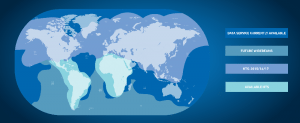Latest News
[Via Satellite 06-19-2014] Testifying to the market opportunity in Asia, Eutelsat announced plans for an early follow-on to its Eutelsat 172A satellite. A new triple-payload satellite designated Eutelsat 172B is slated to launch in 2017 at 172 degrees east to boost capacity and expand coverage across the Asia-Pacific. Panasonic Avionics will anchor a high throughput Ku-band payload to the spacecraft to upscale its bandwidth for In-Flight Connectivity (IFC).
Currently, Eutelsat 172A carries a payload of 20 Ku-band transponders that use five interconnecting beams and 18 C-band transponders connected to a trans-Pacific beam. The new satellite, in addition to the high throughput payload, is designed to support a regular Ku-band payload that will double the capacity provided at the orbital position of 172 degrees east. The Eutelsat 172B regular Ku-band payload will cover the North Pacific, Northeast Asia, Southeast Pacific, Southwest Pacific and the South Pacific. The third payload is dedicated to increasing the available C-band capacity and also opening up new markets in Southeast Asia.
“In addition to delivering significant scope for growth for existing clients, this highly efficient asset in the sky places our 172 degrees east position front and center of the rapidly expanding market for mobile services in the Pacific Ocean region,” said Michel de Rosen, chairman and CEO, Eutelsat.
The new satellite fits nicely with Panasonic’s desire to grow its presence in Asia. Last year the company purchased a full transponder of Ku-band capacity from Australian Satellite Communications (ASC) to use Eutelsat 172A for its Global Communications Service. That deal provided additional capacity for airline routes over Australia, New Zealand and for trans-Tasman flights. Panasonic also has agreements with Intelsat for capacity on the upcoming EpicNG satellites, Intelsat 33E and Intelsat 29E.
According to Panasonic, 99.6 percent of all airline routes are currently covered by its service. The most recent agreement, signed with Eutelsat’s U.S. subsidiary Eutelsat America, brings greater in-flight broadband to high traffic flight paths from North America’s West Coast to Asia, down to Australia and over several Pacific islands.
“Demand for in-flight connectivity is increasing exponentially, especially in Asia. This agreement with a capable technology partner such as Eutelsat represents a continuation of our commitment to serve the aviation industry with the most capable and comprehensive connectivity solution available today and in the future,” said Paul Margis, president and CEO of Panasonic Avionics.
The agreement shows Panasonic’s faith in the abilities of High Throughput Satellites (HTS), which employ frequency reuse technologies in tandem with spot beams to deliver greater bandwidth. With the addition of Eutelsat 172B, Panasonic will be able to provide up to 200 Mb per spot beam. HTS can more economically deliver up to eight channels of live television to passengers though the use of a broad overlay beam, a feature Panasonic is also interested in using. The satellite’s total throughput is 1.8 Gbps. For Eutelsat, the deal provides additional rationale to invest in the Asia-Pacific, which it sees as a high growth region.
Get the latest Via Satellite news!
Subscribe Now